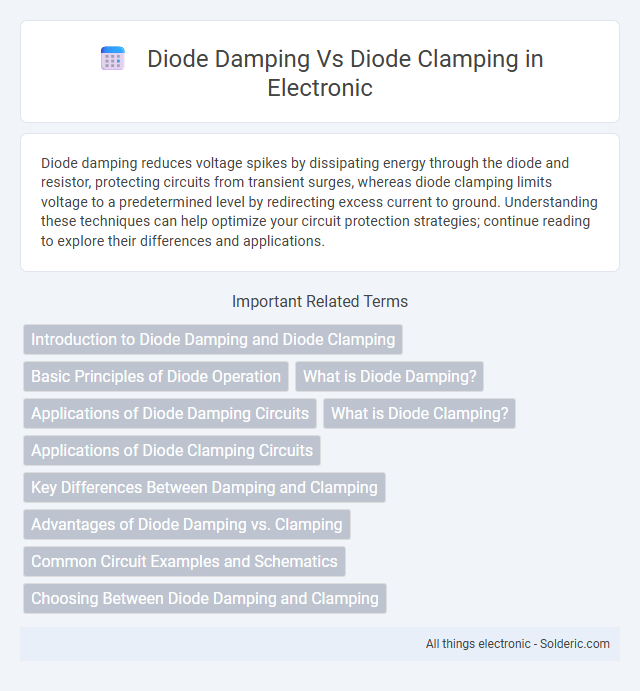Diode damping reduces voltage spikes by dissipating energy through the diode and resistor, protecting circuits from transient surges, whereas diode clamping limits voltage to a predetermined level by redirecting excess current to ground. Understanding these techniques can help optimize your circuit protection strategies; continue reading to explore their differences and applications.
Comparison Table
| Feature | Diode Damping | Diode Clamping |
|---|---|---|
| Purpose | Reduces oscillations and ringing in circuits | Limits voltage to a fixed level to protect components |
| Function | Absorbs transient energy via diode and resistor | Redirects excess voltage to ground or supply rail |
| Typical Application | RLC circuit stabilization, switching circuits | Voltage protection in signal lines, power supplies |
| Component Configuration | Diode in series with resistor or RC network | Diode connected in parallel with load or line |
| Voltage Behavior | Gradually dissipates transient voltage spikes | Clamps voltage at diode forward voltage threshold |
| Energy Dissipation | Dissipates energy across resistor | Redirects and limits voltage, minimal dissipation |
| Effectiveness | Effective at damping high frequency oscillations | Effective at protecting against voltage surges |
Introduction to Diode Damping and Diode Clamping
Diode damping uses diodes to reduce oscillations in circuits by dissipating energy through resistive elements, improving signal stability. Diode clamping limits voltage levels by clamping the output to predefined reference voltages, protecting components from voltage spikes. Both techniques enhance circuit performance but serve distinct roles in managing transient behavior and voltage control.
Basic Principles of Diode Operation
Diode damping utilizes a diode to dissipate energy and reduce voltage spikes by allowing current to flow only during transient events, protecting circuits from overshoot. Diode clamping confines voltage levels within safe limits by redirecting excess voltage away from sensitive components, maintaining a stable operating range. Understanding your circuit's voltage behavior helps decide whether diode damping or clamping best safeguards its performance and longevity.
What is Diode Damping?
Diode damping is a technique used to reduce voltage spikes and oscillations in electrical circuits by incorporating diodes that dissipate energy during transient events. Unlike diode clamping, which limits voltage to a fixed level by redirecting excess current, diode damping gradually absorbs energy to smooth out fluctuations and protect sensitive components. Understanding diode damping helps you enhance circuit stability and improve overall system reliability by effectively managing high-frequency noise and transient voltages.
Applications of Diode Damping Circuits
Diode damping circuits are primarily used in RF and microwave applications to reduce signal reflections and oscillations, improving the stability of amplifiers and mixers. They help protect sensitive components by absorbing transient voltages and controlling ringing in transmission lines. These circuits are essential in high-frequency communication devices, ensuring signal integrity and minimizing distortion.
What is Diode Clamping?
Diode clamping is a technique used in electronic circuits to restrict voltage levels within a specified range by diverting excess voltage to a reference point, typically ground, through a diode. This method protects sensitive components from voltage spikes by quickly shunting transient voltages, ensuring signal integrity and circuit stability. Unlike diode damping, which dissipates energy to reduce oscillations, diode clamping focuses on voltage level control and voltage spike prevention.
Applications of Diode Clamping Circuits
Diode clamping circuits are widely used in signal processing to fix the voltage level of signals, preventing them from drifting outside a specified range, which is essential in waveform shaping and voltage reference stabilization. Common applications include protecting sensitive electronic components from voltage spikes, ensuring consistent logic levels in digital circuits, and restoring the baseline voltage in communication systems. These circuits are integral in maintaining signal integrity in oscilloscopes, video signal processing, and peak voltage detection systems.
Key Differences Between Damping and Clamping
Diode damping reduces transient oscillations by dissipating energy stored in reactive components, effectively minimizing voltage spikes through controlled energy loss. Diode clamping limits voltage amplitude by redirecting excess voltage to a reference point, typically ground, preventing the voltage from exceeding a set threshold. The key difference lies in damping focusing on energy dissipation to smooth transients, while clamping focuses on voltage level restriction to protect circuits from overvoltage conditions.
Advantages of Diode Damping vs. Clamping
Diode damping provides superior protection against voltage spikes by dissipating energy safely, reducing the risk of circuit damage more effectively than diode clamping. It enhances circuit stability and improves transient response, making it ideal for high-frequency applications where rapid voltage fluctuations occur. Your system benefits from lower electromagnetic interference and increased reliability when using diode damping compared to traditional diode clamping methods.
Common Circuit Examples and Schematics
Diode damping circuits, commonly used in relay and motor drive applications, employ diodes to suppress voltage spikes by dissipating energy through a resistive path, illustrated in simple schematic diagrams featuring a diode parallel to the inductive load and a series resistor. Diode clamping circuits, often found in switching power supplies and protection circuits, utilize diodes to clamp voltage excursions to safe levels, shown in schematics as diodes connected between the circuit node and a reference voltage or ground. Both circuit types enhance circuit reliability by controlling transient voltages, with damping circuits focusing on energy dissipation and clamping circuits on voltage limitation.
Choosing Between Diode Damping and Clamping
Choosing between diode damping and diode clamping depends on the specific application and the nature of transient voltage or current. Diode damping is effective for reducing oscillations in resonant circuits by dissipating energy, while diode clamping limits voltage spikes by redirecting excess energy to a safe reference level. Engineers often select diode clamping for protecting sensitive components from voltage surges, whereas diode damping is preferred for improving signal stability in RF and switching circuits.
Diode Damping vs Diode Clamping Infographic

 solderic.com
solderic.com